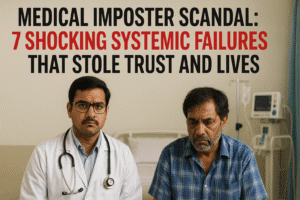Medical Imposter Scandal: 7 Shocking Systemic Failures That Stole Trust and Lives
A shocking case of medical fraud unfolded in Madhya Pradesh when Satyendra Nishad, posing as Dr. Brijraj Uike, was exposed after a patient’s death revealed his decade-long deception. Using stolen documents from his school friend—a painter belonging to the tribal community—Satyendra fraudulently secured an MBBS seat under the tribal quota, bypassing systemic checks. His impersonation unraveled when a railway officer, Manoj Kumar, investigated his mother’s suspicious death at a Jabalpur hospital and discovered the “doctor” lacked a legitimate identity.
The real Brijraj, whose caste certificates and academic records were misused, had reported the theft years earlier, exposing gaps in education and healthcare verification processes. Satyendra’s elaborate scheme, which included obtaining MCI registration and working at government hospitals, highlights vulnerabilities in India’s reservation system and medical credential oversight. The incident has sparked legal action, with charges of forgery and impersonation, while raising urgent questions about institutional accountability and patient safety. Authorities now face pressure to strengthen safeguards to prevent identity-driven fraud in critical professions.

Medical Imposter Scandal: 7 Shocking Systemic Failures That Stole Trust and Lives
In a chilling tale of deception, a man’s quest to become a doctor unraveled after a patient’s tragic death, revealing not just a personal betrayal but glaring cracks in India’s healthcare safeguards. Satyendra Nishad, a 30-year-old from Madhya Pradesh, spent nearly a decade masquerading as Dr. Brijraj Uike—a fraud that underscores the vulnerabilities in medical credential verification and the human cost of institutional oversight.
The Unraveling: A Son’s Quest for Answers
The scheme collapsed when Manoj Kumar, a railway officer, questioned the circumstances of his mother’s death at Jabalpur’s Marble City Hospital in May 2025. Despite being told his mother needed a ventilator, hospital records falsely claimed the family refused the treatment. Suspicious, Kumar investigated the attending “Dr. Brijraj Uike,” only to discover the physician didn’t exist. The man behind the name was Satyendra Nishad, a former classmate of the real Brijraj—a painter whose stolen documents had fueled the ruse.
Anatomy of a Fraud
Satyendra’s deception began in 2012 when he allegedly stole his friend’s Class 12 marksheet and tribal caste certificate. Using these, he secured MBBS admission in 2018 under Madhya Pradesh’s tribal quota—a system designed to uplift marginalized communities but exploited here for personal gain. He later obtained MCI registration, completed a specialization, and worked at both government and private hospitals, evading detection for years.
Key Systemic Failures:
- Document Verification Gaps: Despite Brijraj reporting his documents missing in 2012, no alerts were integrated into education or medical systems, allowing Satyendra to exploit them unchecked.
- Quota System Vulnerabilities: Reserved seats, while critical for equity, became a loophole for fraudsters due to lax checks on claim authenticity.
- Hospital Oversights: Employers relied on surface-level credential checks, trusting MCI registration without tracing documents back to their source.
Victims Beyond the Operating Room
The fallout extended beyond the deceased patient. The real Brijraj Uike, now entangled in legal chaos, faces an identity crisis. “I’m a painter—not a doctor. My life’s upended by someone else’s lies,” he lamented. For Manoj Kumar, the betrayal is twofold: losing his mother and realizing her care was entrusted to an imposter.
Legal Reckoning and Lingering Questions
Satyendra, now absconding, faces charges under IPC sections 420 (cheating), 467 (forgery), and 419 (impersonation), among others. If convicted, he could face years in prison. Yet, the case raises urgent questions:
- How many other “doctors” might be practicing with falsified credentials?
- Can technology, like biometric verification or blockchain-based document tracking, prevent such fraud?
- What accountability do hospitals bear for hiring staff without rigorous background checks?
A Call for Systemic Vigilance
This incident is a wake-up call for healthcare institutions and policymakers. Strengthening document verification processes, mandating periodic audits of medical registrations, and enhancing transparency in patient care records are critical steps. For patients, it underscores the importance of seeking second opinions and verifying practitioner credentials—a daunting but necessary task in preserving trust in healthcare.
As authorities hunt for Satyendra, the case remains a stark reminder: systems designed to protect can become tools for exploitation if vigilance falters. The price of such failures isn’t just financial or reputational—it’s measured in human lives.
You must be logged in to post a comment.